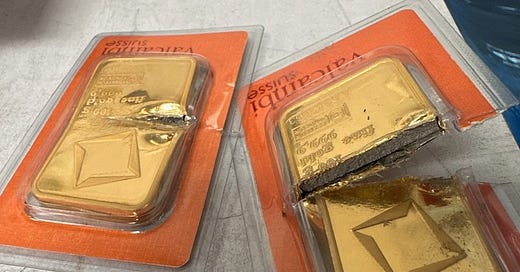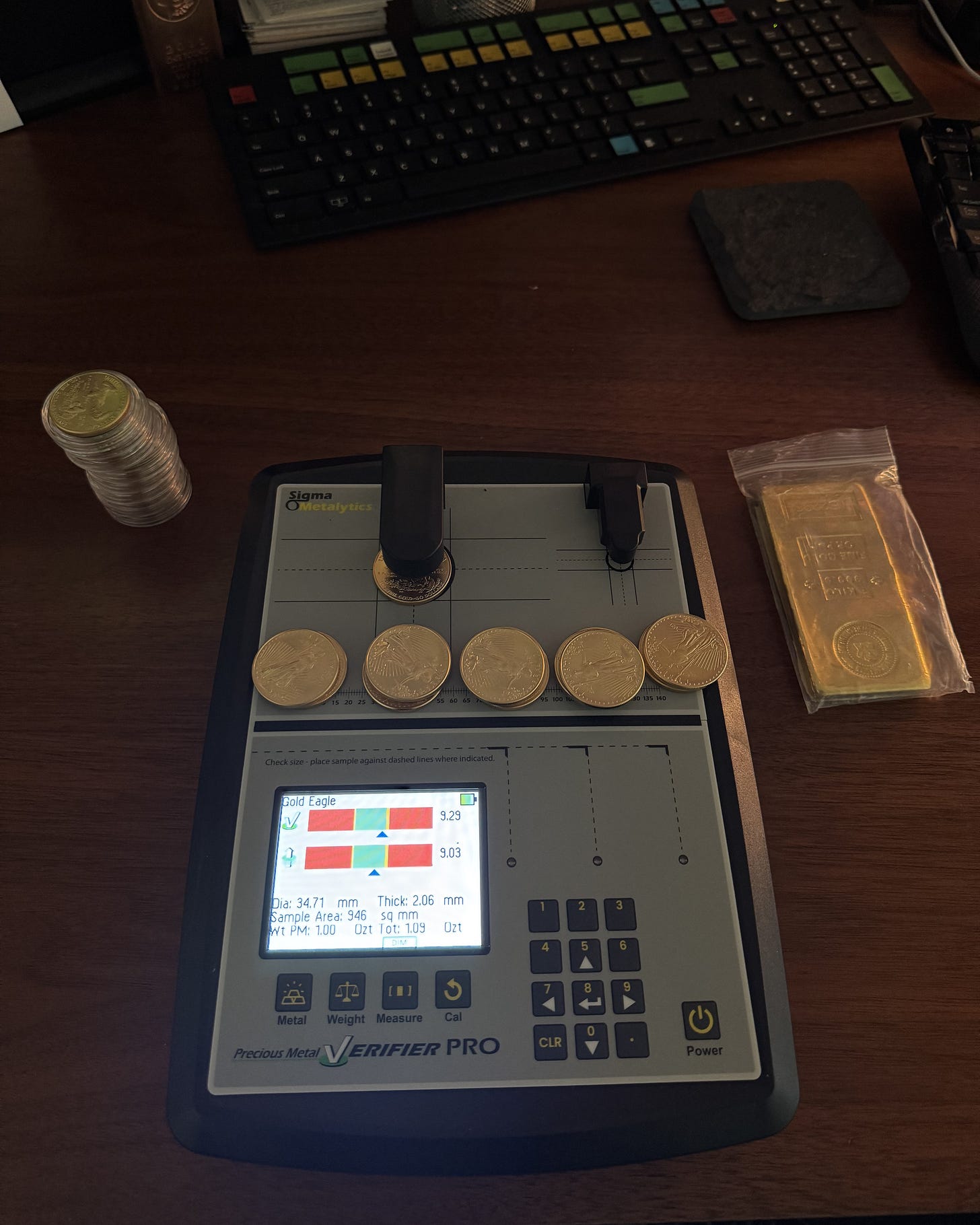The story usually goes like this…
Someone has a great deal for you on gold bars. They bought them in bulk, or direct from somewhere, or have a connection, or in the worst case, stole them and need a fence. If you fence anything, always assume the worst.
The “gold at below-market prices” scheme only works on people who don’t know anything about the gold market. It’s like buying discounted diesel from a guy in an unmarked tanker. It’s either waterlogged, or stolen.
The higher the gold price, the more fake gold shows up. $3,350 an ounce is plenty of incentive to defraud buyers. Just wait until the masses clamor for gold, if they ever do.
The most common way to produce fake gold is paint real gold on the outside of a cheaper metal like tungsten. You can get that core filler for ~$17 an ounce on Amazon. It’s even cheaper in bulk.
Think gold-plated jewelry, in solid bar form. Then dressed up with fake packaging, credible logos, and voila, pure alchemy.
The 100-gram bars below should be 3.21507 troy ounces of gold each. The market value is ~$10,770/ea or $21,540 for the two. If, that is, it’s real gold.
Notice the Valcambi logo on each package. That’s one of 66 refiners approved for “good delivery” by the London Bullion Market Association, or LBMA. Good delivery means the LBMA accepts Valcambi product for delivery into its vaults, in larger ~400-ounce bars.
In this case, the buyer took delivery of bars worth a fraction of the $21,540 market price for 6.43 troy ounces of gold. 6.43 troy ounces of tungsten runs ~$100. Throw in the cost of skilled labor to fabricate the bars, and the producer had an unbeatable spread on the sale.
Stay Out of the Shadows
While it might seem like a one-off or rare circumstance…the fake bars…one quick visit to the r/Gold page on Reddit shows it happens all the time.
Worse yet, only people who figure it out end up posting on Reddit. Untold numbers of bargain-seeking buyers store the fake gold passing on disappointment to future generations.
Part of the problem stems from the common American dual diagnosis of FOMO (fear of missing out) and coupon syndrome. That means finding a way to get yesterday’s price on today’s asset.
First the FOMO drives them to covet the perceived success of others. They won’t be left behind, and need a bargain to make up for lost time. That’s where the coupon syndrome comes in. Think poorly informed car lot customer desperate to impress people meets savvy, cunning, and transient salesman.
Scammers see it coming from a mile away. The buyer first tries traditional routes. A reputable gold dealer offers them a 1-ounce U.S. gold Eagle for $3,450.
The buyer, who won’t be fooled here, says that’s ~$100 more than the gold price quoted on financial websites. Dealer explains the mint pressed the coin, they bought it from the mint, shipped it, are on the phone with you now, and after payment plan to ship the coin to you…all that for $100 seems more than fair.
Buyer scoffs and heads online to outsmart the trustworthy dealer. The real motivation… people want yesterday’s price for today’s popular asset.
Here’s where the real trouble starts. Short on industry knowledge and void of common sense generally, the buyer stumbles drunkenly into digital marketing funnels becoming convinced the coin displayed at an online auction site looks just like that U.S. gold Eagle the reputable dealer offered…meaning that dealer tried to play them for a fool.
If the fake coin or bar ever arrives, chances are the average pedestrian won’t know the difference.
The smartest con artists don’t ship the coin at all… They realize producing the fake eats into profit margins.
If the coin does arrive, the chances of anyone testing the gold with proper equipment are almost zero.
The Price of Certainty
I’ve never bought gold from a below-market source. If I do someday… I’ll carry my Sigma Metalytics PMV Pro with me.
The Pro costs about $2,300 and tests common coins and bars in four key ways:
Surface Resistivity – Electrical resistance near the coin surface to detect impurities
Total Resistivity – Electrical resistance through the coin to detect a false core
Thickness – Common coins and bars should be of similar thickness
Dimensions – Density of common coins and bars
The two most important results during testing are resistivity and density. Essentially, a fake coin will fail one of those.
This morning, I fired up the Sigma PMV Pro to test coins bought from a formerly trusted dealer, Gainesville Coins. It’s a good reminder, nothing in life is permanent.
I did business with them for the first time in 2008, just shy of 17 years ago. I never had an issue through many, many transactions. Until recently.
For the last few years I used other dealers, out of new friendship and convenience. Those dealers were away or busy in April when I needed 20 coins and wanted to lock in the price. Gold trades round-the-clock and delaying action has a price.
That’s why I went back to the old relationship, trusting my 15 years of prior good transactions. 13 weeks later, I still don’t have all the coins… Gainesville Coins has interest-free use of my money in the meantime.
These are common 1oz coins. Other dealers tell me they’re swimming in supply… it seems like average buyers in the 2011 market run-up want to sell now…which tells me prices could go higher. This class of buyer is most often a contrary indicator.
13 weeks and two shipments later, I still don’t have 25% of the order. It’s so unusual, I’ll now test the authenticity of every coin they send.
Needless to say… it’ll be my last transaction with this group.
Rich Vs. Wealthy
I’m sure the balance of my coin order will arrive…eventually. Once tested, I’ll chalk the whole situation up as a one-time headache. What matters more is having the gold.
I want a certain percentage of assets held in gold. I’m not too concerned about the price. People seem confused by this.
They struggle with it because of their own baggage. They’re rushing around looking for ways to “get rich” and can’t understand anything else. Especially that they’ll never get there with that mentality.
Most people can’t get over their own hangups. Crippled by their need for overnight success, they never notice successful people got there through a combination of right-minded thinking, good habits, patience, and luck.
They only see E.B. Tucker as a man who does whatever he wants…most of the time. But that’s only part of the picture. They’ll overlook E.B. Tucker the goal-setting younger version, deeply dismayed about his lack of freedom and flexibility…
That much less wealthy and much younger man chipped small amounts of paycheck cash into DRIP (Dividend Reinvestment Plan) programs where blue chips like Exxon Mobile Corp (XOM) or FedEx Corp (FDX) picked up the tab for commissions on stock bought through these company-sponsored plans. This was a long time ago… when we paid commissions to buy stock.
It’s no Horatio Alger tale… it’s just a highly-caffeinated young guy reading all the business periodicals in the Borders Bookstore café until being asked to buy something or leave. We were in a recession at the time. Blue chip value stocks outperformed the wounded growth stocks. I wanted to keep up with the situation.
Chipping away at things paid off. My meager savings grew faster than the broader indexes, yielding enough cash to finance a move to West Palm Beach, FL about 18 months later. I got a low-six-figure job offer…quadruple the gross earnings of the job I had which created the savings. I sold those stocks, investing the money instead in an upgraded life. I’m glad I had the stock to sell. If I’d been unprepared, I might still be stuck in low gear.
The Tucker Kids endure stories like this on repeat. Drilled into their mush-like brains while burning down the highway between junior tennis events…
Treat $100 like it’s $100 million. The way you treat money determines how much of it flows your way. That’s the path to real, sustainable wealth. It comes when it comes… but when it comes, if you’re not ready, it’ll disappear at the same pace.
It doesn’t mean clipping coupons and depriving yourself either. The $100 to $10,000 to $10,000,000 is all about management. It’s how you protect, put to work, and care for what you have. That’s what matters. Not the amount. Turn it into percentages, and the decisions get a lot easier.
When it comes to gold, I decided long ago there was a small percentage of assets I wanted held in physical coins. Eventually it moved to bars, due to the size of the overall pile…which got a lot larger. I think, as a result of good management.
When an extra chunk comes in these days, a % goes into various categories, like gold, and others, which we’ll discuss later in the issue, past the paywall.
What I hope the Tucker Kids absorb is, people who merely want to be rich, make videos of themselves in rented cars, wear watches on their ankles, etc… they rarely get there. They can earn, speculate, gamble, and make a lot of noise… But over time, they blow up. They lack the skills needed to create longterm stability.





